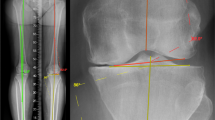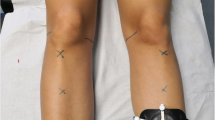Abstract
Despite the increase in clinical use of navigation systems in total knee arthroplasty, few studies have focused on the reproducibility of these systems. The aim of the present study was to assess the influence of knee position and observer experience on intra- and inter-observer agreement in limb alignment assessment with the OrthoPilot system. Limb alignment in the coronal plane and extension range of the knee were assessed in four embalmed cadaveric specimens by five independent observers and measurements were repeated four times to determine intra- and inter-observer agreement, expressed as intraclass correlation coefficients (ICCs). Additionally, navigation results were compared against figures from conventional measurement of leg alignment (ground truth). Intra- and inter-observer agreements were excellent for assessing the extension range (ICC, 0.97 and 0.95) and the coronal femuro-tibial axis in knee extension (ICC, 0.92 and 0.88) but were generally worse in knee flexion (ICC, 0.62 and 0.55). There was an increased tendency of intraobserver errors in observers with less clinical experience. Mean correlation with conventional measurements was fair (Spearman’s rho 0.61). The OrthoPilot system showed excellent reproducibility for assessment of extension range and coronal limb alignment. However, assessments of coronal limb alignment in flexion were prone to error and caution should be taken when relying on these measurements.



Similar content being viewed by others
References
Abbot LC, Walter F, Carpenter WF (1945) Surgical approaches to the knee joint. J Bone Jt Surg Am 27:277–310
Bargren JH, Blaha JD, Freeman MA (1983) Alignment in total knee arthroplasty. Correlated biomechanical and clinical observations. Clin Orthop Relat Res 173:178–183
Bathis H, Perlick L, Luring C, Kalteis T, Grifka J (2003) CT-based and CT-free navigation in knee prosthesis implantation. Results of a prospective study. Unfallchirurg 106:935–940
Bathis H, Perlick L, Tingart M, Luring C, Zurakowski D, Grifka J (2004) Alignment in total knee arthroplasty. A comparison of computer-assisted surgery with the conventional technique. J Bone Jt Surg Br 86:682–687. doi:10.1302/0301-620X.86B5.14927
Bathis H, Shafizadeh S, Paffrath T, Simanski C, Grifka J, Luring C (2006) Are computer assisted total knee replacements more accurately placed? A meta-analysis of comparative studies. Orthopade 35:1056–1065. doi:10.1007/s00132-006-1001-3
Bauwens K, Matthes G, Wich M, Gebhard F, Hanson B, Ekkernkamp A, Stengel D (2007) Navigated total knee replacement. A meta-analysis. J Bone Jt Surg Am 89:261–269. doi:10.2106/JBJS.F.00601
Bejek Z, Solyom L, Szendroi M (2007) Experiences with computer navigated total knee arthroplasty. Int Orthop 31:617–622. doi:10.1007/s00264-006-0254-0
Bolognesi M, Hofmann A (2005) Computer navigation versus standard instrumentation for TKA: a single-surgeon experience. Clin Orthop Relat Res 440:162–169. doi:10.1097/01.blo.0000186561.70566.95
Caillouette JT, Anzel SH (1990) Fat embolism syndrome following the intramedullary alignment guide in total knee arthroplasty. Clin Orthop Relat Res 251:198–199
Fleiss JL (1986) The design and analysis of clinical experiments. Wiley, New York
Goleski P, Warkentine B, Lo D, Gyuricza C, Kendoff D, Pearle AD (2008) Reliability of navigated lower limb alignment in high tibial osteotomies. Am J Sports Med 36:2179–2186. doi:10.1177/0363546508319314
Hinman RS, May RL, Crossley KM (2006) Is there an alternative to the full-leg radiograph for determining knee joint alignment in osteoarthritis? Arthritis Rheum 55:306–313. doi:10.1002/art.21836
Ishii Y, Ohmori G, Bechtold JE, Gustilo RB (1995) Extramedullary versus intramedullary alignment guides in total knee arthroplasty. Clin Orthop Relat Res 318:167–175
Jeffery RS, Morris RW, Denham RA (1991) Coronal alignment after total knee replacement. J Bone Jt Surg Br 73:709–714
Jenny JY, Boeri C (2004) Low reproducibility of the intra-operative measurement of the transepicondylar axis during total knee replacement. Acta Orthop Scand 75:74–77. doi:10.1080/00016470410001708150
Jenny JY, Boeri C, Picard F, Leitner F (2004) Reproducibility of intra-operative measurement of the mechanical axes of the lower limb during total knee replacement with a non-image-based navigation system. Comput Aided Surg 9:161–165. doi:10.1080/10929080500095517
Jenny JY, Clemens U, Kohler S, Kiefer H, Konermann W, Miehlke RK (2005) Consistency of implantation of a total knee arthroplasty with a non-image-based navigation system: a case–control study of 235 cases compared with 235 conventionally implanted prostheses. J Arthroplasty 20:832–839. doi:10.1016/j.arth.2005.02.002
Kendoff D, Board TN, Citak M, Gardner MJ, Hankemeier S, Ostermeier S, Krettek C, Hufner T (2008) Navigated lower limb axis measurements: influence of mechanical weight-bearing simulation. J Orthop Res 26:553–561. doi:10.1002/jor.20510
Kendoff D, Citak M, Pearle A, Gardner MJ, Hankemeier S, Krettek C, Hufner T (2007) Influence of lower limb rotation in navigated alignment analysis: implications for high tibial osteotomies. Knee Surg Sports Traumatol Arthrosc 15:1003–1008. doi:10.1007/s00167-007-0308-x
Krettek C, Miclau T, Grun O, Schandelmaier P, Tscherne H (1998) Intraoperative control of axes, rotation and length in femoral and tibial fractures. Technical note. Injury 29(3):C29–C39. doi:10.1016/S0020-1383(98)95006-9
Laskin RS, Beksac B (2006) Computer-assisted navigation in TKA: where we are and where we are going. Clin Orthop Relat Res 452:127–131. doi:10.1097/01.blo.0000238823.78895.dc
Oberst M, Bertsch C, Lahm A, Wuerstlin S, Holz U (2006) Regression and correlation analysis of preoperative versus intraoperative assessment of axes during navigated total knee arthroplasty. Comput Aided Surg 11:87–91. doi:10.1080/10929080600632680
Reed SC, Gollish J (1997) The accuracy of femoral intramedullary guides in total knee arthroplasty. J Arthroplasty 12:677–682. doi:10.1016/S0883-5403(97)90141-8
Ritter MA, Faris PM, Keating EM, Meding JB (1994) Postoperative alignment of total knee replacement. Its effect on survival. Clin Orthop Relat Res 299:153–156
Rosenberger RE, Fink C, Quirbach S, Attal R, Tecklenburg K, Hoser C (2008) The immediate effect of navigation on implant accuracy in primary mini-invasive unicompartmental knee arthroplasty. Knee Surg Sports Traumatol Arthrosc 16:1133–1140. doi:10.1007/s00167-008-0618-7
Rosenberger RE, Hoser C, Quirbach S, Attal R, Hennerbichler A, Fink C (2008) Improved accuracy of component alignment with the implementation of image-free navigation in total knee arthroplasty. Knee Surg Sports Traumatol Arthrosc 16:249–257. doi:10.1007/s00167-007-0420-y
Shrout PE, Fleiss JL (1979) Intraclass correlations: uses in assessing rater reliability. Psychol Bull 86:420–427. doi:10.1037/0033-2909.86.2.420
Specogna AV, Birmingham TB, Hunt MA, Jones IC, Jenkyn TR, Fowler PJ, Giffin JR (2007) Radiographic measures of knee alignment in patients with varus gonarthrosis: effect of weight bearing status and associations with dynamic joint load. Am J Sports Med 35:65–70. doi:10.1177/0363546506293024
Yaffe MA, Koo SS, Stulberg SD (2008) Radiographic and navigation measurements of TKA limb alignment do not correlate. Clin Orthop Relat Res 466:2736–2744. doi:10.1007/s11999-008-0427-9
Yau WP, Leung A, Chiu KY, Tang WM, Ng TP (2005) Intraobserver errors in obtaining visually selected anatomic landmarks during registration process in nonimage-based navigation-assisted total knee arthroplasty: a cadaveric experiment. J Arthroplasty 20:591–601. doi:10.1016/j.arth.2005.02.011
Yau WP, Leung A, Liu KG, Yan CH, Wong LL, Chiu KY (2007) Interobserver and intra-observer errors in obtaining visually selected anatomical landmarks during registration process in non-image-based navigation-assisted total knee arthroplasty. J Arthroplasty 22:1150–1161. doi:10.1016/j.arth.2006.10.010
Yau WP, Leung A, Liu KG, Yan CH, Wong LS, Chiu KY (2008) Errors in the identification of the transepicondylar and anteroposterior axes of the distal femur in total knee replacement using minimally-invasive and conventional approaches: a cadaver study. J Bone Jt Surg Br 90:520–526. doi:10.1302/0301-620X.90B4.19841
Acknowledgments
The authors would like to thank Aesculap for providing the OrthoPilot system used in this study, and Prof. Martin Scaal from the University’s Institute for Anatomy, for granting access to the cadaveric specimens.
Conflict of interest statement
The authors state that there were no conflicts of interest for any of the authors. Observer D is an employee of Aesculap. With this exception, Aesculap was not involved in data acquisition. Aesculap was not involved in study design, data analysis and interpretation, or the writing of the manuscript and had no influence on the decision of publication of the study.
Author information
Authors and Affiliations
Corresponding author
Rights and permissions
About this article
Cite this article
Hauschild, O., Konstantinidis, L., Strohm, P.C. et al. Reliability of leg alignment using the OrthoPilot system depends on knee position: a cadaveric study. Knee Surg Sports Traumatol Arthrosc 17, 1143–1151 (2009). https://doi.org/10.1007/s00167-009-0825-x
Received:
Accepted:
Published:
Issue Date:
DOI: https://doi.org/10.1007/s00167-009-0825-x




